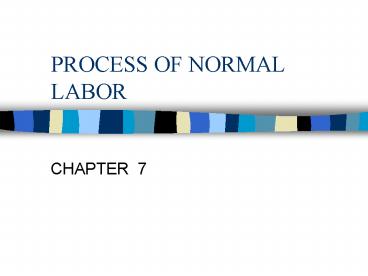PROCESS OF NORMAL LABOR - PowerPoint PPT Presentation
1 / 16
Title:
PROCESS OF NORMAL LABOR
Description:
Lightening: 'baby drops down', baby settles in maternal pelvis ... support fetal head and check position of umbilical cord= nuchal cord ... – PowerPoint PPT presentation
Number of Views:807
Avg rating:3.0/5.0
Title: PROCESS OF NORMAL LABOR
1
PROCESS OF NORMAL LABOR
- CHAPTER 7
2
Events Before Onset of Labor
- Unknown what actually starts labor
- Lightening baby drops down, baby settles in
maternal pelvis - Vaginal discharge or bloody show pink stained
mucus - Energy spurt or nesting time
- False labor no cervical dilatation
- Spontaneous rupture of membranes or SROM
- Cervical changes effacement dilatation
- see Figures 7-1,Table 7-1
3
Major Variables in the Birth Process The 4 Ps
- PELVIS--size and shape of the pelvis
- PASSENGER- fetus size and position
- POWERS-effectiveness of contractions
- PSYCHE-preparation, previous experience
4
PELVIS
- Must be adequate proportions in order for the
fetal head to fit through - Angles are downward, forward, upward somewhat
like the letter J
5
PASSENGER
- Fetal Head must be able to stand extreme
pressure - Fetal Bony Skull bones thin, very elastic,
allows for molding
6
Fetopelvic Relationship
- Terminology
- Attitude, fig 7-3
- Lie relationship of the longitudinal axis of
the fetus to the mother, should be parallel, not
crosswise - Presentation, body part lowest in mothers
pelvis, fig 7-4 - Position, more specific description of the
relationship of the fetal presenting part to the
maternal pelvis, fig 7-4 - Station fig 7-5, -5 to 5, ischial spines used,
hardest to determine during a vaginal exam
7
POWERS-UTERINE CONTRACTIONS
- Involuntary
- Intermittent but regular
- Exhibit a wavelike pattern in 3 phases
- Increment, building up
- Acme, peak
- Decrement, decreasing intensity
- Affected by maternal position
- supine, more freq, lower intensity
- side lying, less freq, more effective
8
Assessment of Uterine Contractionsfig 7-6
- Frequency amount of time between the beginning
of one contraction to the beginning of the next - Duration time between the onset of the
contraction its end - Intensity strength of the contraction, rough
estimate made by palpation - mild easy to indent, like touching tip of
nose - moderate harder to indent but still able to
touching the chin - strong fundus is very firm difficult to
indent, like touching the forehead
9
PSYCHE--Psychological and Cultural factors that
affect labor
- Anxiety and fear can decrease ability to cope,
previous poor experience can effect present
experience negatively - Culture, ethnic background may play a strong role
in the way a woman perceives labor and her
reaction to it - Maternal/newborn bonding very important!
10
MECHANISMS OF LABOR (cardinal movements)
- Figure 7-7
- Engagement and decent
- Flexion
- Internal rotation
- Extension
- Crowning
- External rotation
- Delivery of anterior shoulder
- Delivery of posterior shoulder
expulsion
11
Placental expulsion
- 5-30 min after delivery s/s lengthening of
cord--change in shape of uterus-trickle or gush
of vaginal blood - Dull- maternal side --Duncans mechanism or Dirty
Duncanusually implanted low in uterus - Shiny- fetal side- Schultzs mechanism or Shiny
Schultzusually implanted high in uterus
12
FOUR STAGES OF LABOR
- 1ST STAGE begins with the onset of regular
contractions until the cervix is fully dilated to
10cm - 2nd STAGE begins when cervix is fully dilated
ends with birth of the infant - 3rd STAGE begins with birth of the baby ends
with expulsion of the placenta - 4th STAGE from placental expulsion to the end
of the recovery stage usually 1-4 hours
13
Phases of 1st STAGE OF LABOR-
- LATENT PHASE-EARLY STAGE 0-4CM EARLY, SLOW PART
- ACTIVE PHASE-MID PHASE 4CM-7CM STRONGER
CONTRACTIONS - TRANSITION PHASE-- LAST PART 8CM-10CM-CONTRACTIONS
STRONGER, MORE FREQUENT LASTING 60-90 SECS
WOMAN BECOMES IRRITABLE, ANXIOUS, SELF FOCUSED
!!!!!
14
Second Stage of Labor
- Expulsion stage cervix 10 cm
- Coach-- do not hold breath more than 5 secs when
pushing - crowning of fetal headseen in external opening
of vaginarecedes after contractions
- Second stage lasts from a few minutes to 2 hours
- episiotomy- midline or mediolateral
- support fetal head and check position of
umbilical cord nuchal cord - Birth relief for laboring woman
15
Third and Fourth Stage
- Third stage-
- Begins with birth to expulsion of placenta lasts
up to 30 minutes - Oxytocin (Pitocin) given to keep uterus firm and
lessen blood loss after delivery of placenta
- Fourth stage-
- Recovery phase after delivery of placenta through
first 1-4 hours or until VS stable. 250-500 ml
blood loss. CRITICAL--Observe for excessive
bleeding! Teach fundal massage.
16
Physiologic Changes in Laborsee table 7-2
- Cardiovascular- increase in b/p, supine
hypotension, increased pulse rate - Respiratory- 02 demand equal to strenous
exercise, hyperventilationencourage to relax
between contractions
- Renal--proteinuria, due to muscle breakdown
distended bladder, due to pressure - GI--peristalsis and absorption decrease--NPO
except ice chips, - hydration by IV































